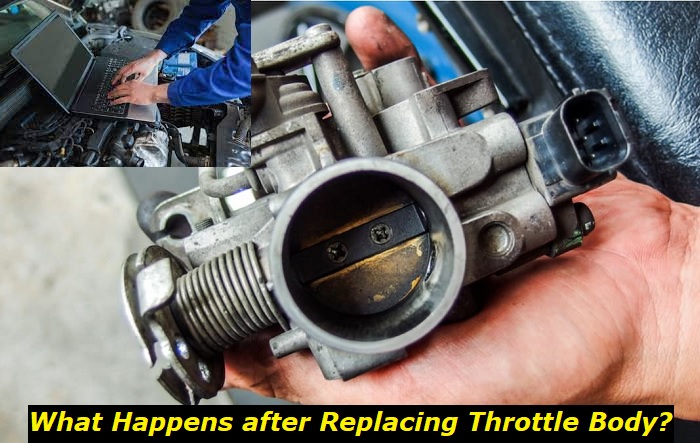The throttle body in a modern vehicle is an essential piece of the air intake system. Located between the air filter and the intake manifold, the throttle body uses a butterfly valve to control the amount of air flowing into the engine. Allowing an accurate amount of air to enter the engine and burning up the fuel in the cylinder plays a crucial role in helping your vehicle to perform at its optimal condition.
Engine use tips highlights
- Level of importance:important
- When done:driving the vehicle, maintaining the engine
- Cost of mistake:$250 - $350
- How to avoid:read advice, read driver's manual
- Consequences:bad efficiency, shorter engine lifespan, engine problems
- DIY solutions:possible

What is the Purpose of a Throttle Body?
The main purpose of a throttle body is to manage the flow of air going into the engine manifold. This tube-shaped housing controls the amount of air entering the engine by using a rotating butterfly valve. The engine speed is directly affected by the amount of air flowing into the engine.
The power that moves the vehicle is created once this air and fuel mixture enters the combustion chamber. The engine speed increases as more air is allowed to flow in and vice-versa, the speed decreases when less air flows into the engine. Without the throttle body functioning properly, there will be insufficient or in some cases, excessive amounts of air in the air and fuel mixture.
A throttle cable connected to the accelerator pedal is used to control the throttle body of your vehicle. However, a throttle position sensor and airflow sensor are used to communicate with the vehicle's computer and provide the necessary fuel to the injectors in an electronically fuel-injected vehicle.
By regulating the amount of airflow going into the engine, the vehicle is able to run accordingly with the speed that is required by the driver.
When the accelerator is pressed down, the throttle body allows more air to enter the engine by opening up. More fuel is burned due to the increase in airflow which results in the engine having more power. On the other hand, the throttle body closes when the accelerator is let off or relieved, decreasing in power as the amount of airflow going into the engine is restricted.
How to Detect if the Throttle Body is Faulty or Needs to be Cleaned?
As part of the engine that mixes air with the fuel in order for combustion to occur, a faulty throttle body can cause other issues around the engine if left unattended.
With a properly functioning throttle body, the fuel intake is synchronized with the accelerator pedal in order for the driver to dictate the speed of the vehicle. There are a number of common symptoms that are related to a throttle body that is faulty or even dirty/clogged up.
Most of the common symptoms related to a malfunctioning throttle body can be solved simply by cleaning the throttle body and properly reinstalling instead of replacing it. Old motor oil, dirt, and debris can build up over years of usage and cause the throttle body to fail to function properly.
So before spending the money to replace it with a new one, first try cleaning the throttle body as it is one of the most common and less costly solutions in most cases.
1) Lack of Power/Issues Accelerating
A malfunctioning throttle body will fail to accurately regulate the airflow and will result in either more or less air entering into the mixture. Ideally, when the accelerator is pressed, more air is allowed to enter the engine, allowing the excess fuel to burn.
However, a malfunctioning throttle body will fail to let in the needed amount of air and the engine will have no surge in power and fail to accelerate as required.
2) Poor or Low Idling
Poor or low idling is one of the more common tell-tale signs of the throttle body of your vehicle not operating effectively. The engine in your vehicle stalling when coming to a stop at a signal or even stalling when pressing down to accelerate are also included in the symptoms. Along with being faulty, dirt clogging up and causing the airflow to be turbulent can also cause poor or low idling.
3) Poor Mileage
A choking throttle body will severely impact the fuel economy of your vehicle. With a lack of power and acceleration issues, it is only natural that your vehicle will burn more gas as you will struggle with the gas pedal and push harder to attain speed. Issues with the throttle body can increase the amount of fuel consumed by your vehicle by more than 15%.
Do You Need to Reprogram a New Throttle Body?
While older vehicles may be equipped with mechanically-controlled throttle bodies operated with a cable, most modern vehicles today have electronically controlled throttle bodies. When the accelerator pedal is pressed, the vehicle's computer receives a signal and informs the throttle body blade to open. A throttle position sensor is used to signal back in order for the computer to know the throttle body blade's actual position.
Therefore, every time a new throttle body is installed, you must reprogram the new throttle body in order for it to adjust and allow the engine to run smoothly. If the new throttle body is not programmed accurately, the engine will have problems running properly as the throttle body controls the amount of air going into the engine.
So whether you are replacing the throttle body with a new one or just reattaching the old one after cleaning it, a throttle body relearn procedure is necessary.
Although it does not take too much time to program a brand-new throttle body, there are different procedures necessary, depending on your vehicle's model and year. Some vehicles are set to automatically reprogram the throttle body after installation once you turn on the engine and let it idle for a few minutes. However, others may require you to take the vehicle out for a ride or even use advanced scan tools.
Once you turn on the engine and let it idle for some time, it will allow the vehicle to get familiar with and used to the newly installed throttle body. With a freshly cleaned or brand-new throttle body, there will be a higher increase in the airflow as well as a faster valve reaction.
Therefore, it is necessary for your vehicle to get used to the much-improved airflow from the properly cleaned or brand-new state-of-the-art throttle body, especially for older engines.
How to Properly Program Throttle Body?
The throttle body found in modern vehicles nowadays is controlled by an electronic throttle control system (ETC). The ETC consists of the throttle position sensor (TPS), the accelerator pedal position sensor (APPS), and the electronic control unit (ECU), all working together to make the engine of the vehicle run properly.
Based on the signal or input from the TPS and APPS, the ECU manages and/or controls the actual opening and closing of the throttle blade.
Depending on the driving conditions and preference, the throttle body may be programmed to open at various rates. In order to prevent the engine from revving too high and causing unnecessary stress that may damage the engine, you can program the throttle body to open at a slower pace if you deal with stop-n-go traffic on your daily commute.
However, if highway driving is what you prefer, it will be better to have the throttle body open up more quickly to get up to the desired speed much faster.
Even though a lot of aftermarket ECUs have built-in software allowing you to modify the settings, you can purchase a tuning device separately that will enable you to modify the setting. By accessing the ECU, you can set up the throttle body settings amongst the different factors and input the new settings into the ECU.
Since making improper changes can cause the engine to run poorly and possibly get damaged, it is better to take your vehicle to a professional if you are not experienced in properly programming the throttle body or tuning the engine.
Conclusion
If you want the engine to work properly without any issues after reinstalling the old throttle body after cleaning or replacing it with a new one, it is necessary to properly go through the relearning process and reprogram your brand-new throttle body. The throttle body is a vital part of the air intake system that controls the amount of air flowing into the engine.
Therefore, if you do not accurately uninstall the damaged or dirty throttle body, properly clean or replace it and then reprogram the newly installed throttle body, you will be faced with all sorts of engine problems.
It is very common for a throttle body to work perfectly after simply cleaning and reprogramming it instead of replacing it with a new one. However, once you replace the throttle body with a new one, it is necessary for the new throttle body and the engine in your vehicle to adapt and get used to one another. If the new throttle body is not installed and programmed properly, you will experience poor engine performance as well as fuel economy issues.
About the authors
The CarAraC research team is composed of seasoned auto mechanics and automotive industry professionals, including individuals with advanced degrees and certifications in their field. Our team members boast prestigious credentials, reflecting their extensive knowledge and skills. These qualifications include: IMI: Institute of the Motor Industry, ASE-Certified Master Automobile Technicians; Coventry University, Graduate of MA in Automotive Journalism; Politecnico di Torino, Italy, MS Automotive Engineering; Ss. Cyril and Methodius University in Skopje, Mechanical University in Skopje; TOC Automotive College; DHA Suffa University, Department of Mechanical Engineering






Add comment